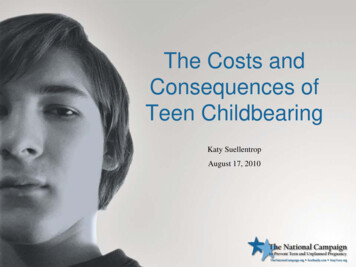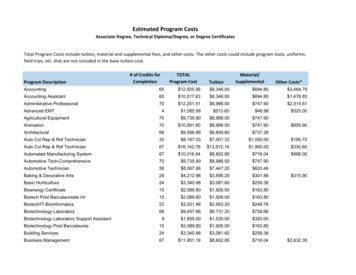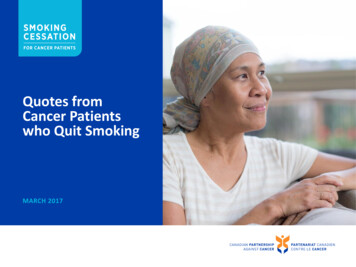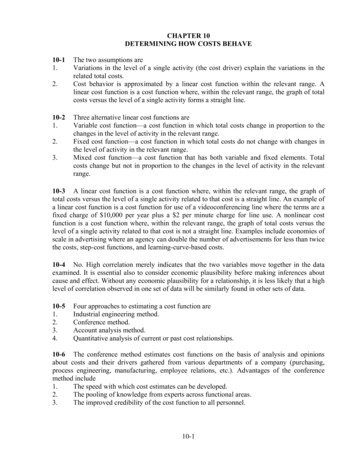
Transcription
The Costs andConsequences ofTeen ChildbearingKaty SuellentropAugust 17, 2010
Still Work to Do Three in ten girls get pregnant once beforethey turn 20 One-quarter of teen parents have a secondchild before they turn 20 Disparities (over 50% of Latinas and AfricanAmericans) Higher teen pregnancy and birth rates thancomparable countries
Consequences for Children Compared to children born to older mothers (20-21years old), children born to teen moms are more likelyto:– drop out of high school.– become teen parents.– use Medicaid and CHIP.– experience abuse/neglect.– enter the foster care system.– end up in prison (sons).– be raised in single parent families.Source: Hoffman, S.D., (2006) By the Numbers: The Public Costs of Adolescent Childbearing.The National Campaign to Prevent Teen Pregnancy: Washington, DC.
Consequences for Children Lower scores on measures of kindergartenreadiness Lower vocabulary, math, and reading scores Greater risk of being born at low birth weightSource: Terry-Humen, E., Manlove, J., and Moore, KA., (2005). Playing Catch-Up: How Children Born to TeenMothers Fare, The National Campaign to Prevent Teen Pregnancy: Washington, DC
Connection with Poverty A child born to a teen mother who has not finishedhigh school and is not married is nine times morelikely to be poor than a child born to an adult whohas finished high school and is married. What if the national teen birth rate had not declined30% between 1991 and 2002? In 2002, 460,000more young children would have been living inpoverty.Source: Analysis of U.S. Congress, Ways and Means Committee-Democrats (2004). Steep Decline in Teen Birth RateSignificantly Responsible for Reducing Child Poverty and Single-Parent Families. (Issue Brief, April 23, 2004). Washington, DC.
Consequences for Education This bar chart shows thepercent of teen mothers whoattain a diploma or GED byage 22, depending on their ageat the birth of this child; 43%of teens who gave birth beforeage 18 had neither compared to27% of teens who gave birth atage 18 or 19Source: Perper, K., Peterson, K., & Manlove, J., Diploma Attachment AmongTeen Mothers, 2010. Child Trends, Fact Sheet: Washington, DC.Retrieved March, 2010 fromhttp://www.childtrends.org/Files//Child Trends2010 01 22 FS DiplomaAttainment.pdfDiploma/GED AttainmentAmong Teen Mothers BeforeAge 22, By Age of BirthPercent of Teens Overall 34% of women whohave a birth as a teen do notattain a diploma or GED byage 22 compared to 6% ofwomen who do not have a Birth AtBefore Age 18Age 1819Age at BirthNeitherGEDDiploma
Connection with Child Welfare Almost one-half of girls in foster care becomepregnant by age 19. Compared to mothers age 20-21, young teen motherswere 2.2 times more likely have a child placed infoster care during the first 5 years after a birth. Delaying age of birth from 17 or earlier to age 20-21would reduce the overall foster care placement rateby 8% percent.Source: Hoffman, S.D., (2006) By the Numbers: The Public Costs of Adolescent Childbearing.The National Campaign to Prevent Teen Pregnancy: Washington, DC.
Public Sector Costs
Methods National data from Kids Having Kids(Maynard 1996) and Kids Having Kids:Revised Edition (Maynard and Hoffman) Measure costs over the first 15 years followinga birth – assume a steady state analysis Annual costs incurred in 2004
Methods (cont.) State costs are derived from national costs Account for the state’s share of teen births, theper client cost (relative to the nationalaverage), and utilization rates (relative to thenational average) State specific income and sales tax structure
National CostsMost of the costs of teen childbearing are associatedwith negative consequences for the children of teenmothers and include:– 1.9 billion for increased public health care costs– 2.3 billion for increased child welfare costs– 2.1 billion for increased costs for state prison systems(among adult sons of teen mothers)– 2.9 billion in lost tax revenue due to lower taxes paidby the children of teen mothers over their own adultlifetimes.Source: Hoffman, S.D., (2006) By the Numbers: The Public Costs of Adolescent Childbearing.The National Campaign to Prevent Teen Pregnancy: Washington, DC.
National Savings The one-third decline in the nation’s teen birth ratebetween 1991 and 2004 resulted in saving taxpayers anestimated 6.7 billion in 2004 alone.
State Specific Costs Average cost associated with a child born to ateen mother ranges from 7,836 in Vermont to 2,997 in Texas. Cost savings in 2004 range from 5 million inWyoming to 1.1 Billion in CA. More detailed information available in thereport and athttp://www.thenationalcampaign.org/costs
Challenges and LimitationsDistribution of Teens by FamilyIncome (at Age 12-19, Before theBirth) for Teens With/Without aChild as a Percent of Poverty How to attribute pooreroutcomes – circumstancesbefore or after the birth100%Percent of Teens The bar chart shows thedistribution of teens byfamily income as a percentof poverty for teens whohad a teen birth and thosewho didn’t; 28% of teenswho had a birth as a teenwere living at 100% ofthe federal povertythreshold compared to16% of all teens80%41%61%60%40%20%31%23%28%16%0%Teens Who Ever Hada Teen BirthTeensAll Teens 200%Poverty100-199%Poverty 100%Poverty
“Reduction of early parenthood will noteliminate the powerful effects of growing up inpoverty and disadvantage. But it represents apotentially productive strategy for wideningthe pathways out of poverty, or at the veryleast, not compounding the handicaps imposedby social disadvantage.”Source: Hoffman, S.D., (1998) Teenage Childbearing Is Not So Bad After All Or Is It? A Review of the Literature.Family Planning Perspectives, 30(5): 236-239;243.
What can be Done Invest in evidence-based programs Intensify efforts with vulnerableyouth/populations with high rates. Enlist parents, media, faith community,business, judges, and others to help.
Thank-you!For more information:Visit our website:http://www.TheNationalCampaign.orgSign up for e-gram updates!
Aug 17, 2010 · years old), children born to teen moms are more likely to: – drop out of high school. – become teen parents. – use Medicaid and CHIP. – experience abuse/neglect. – enter the foster care system. – end up in prison (sons). – be raised











